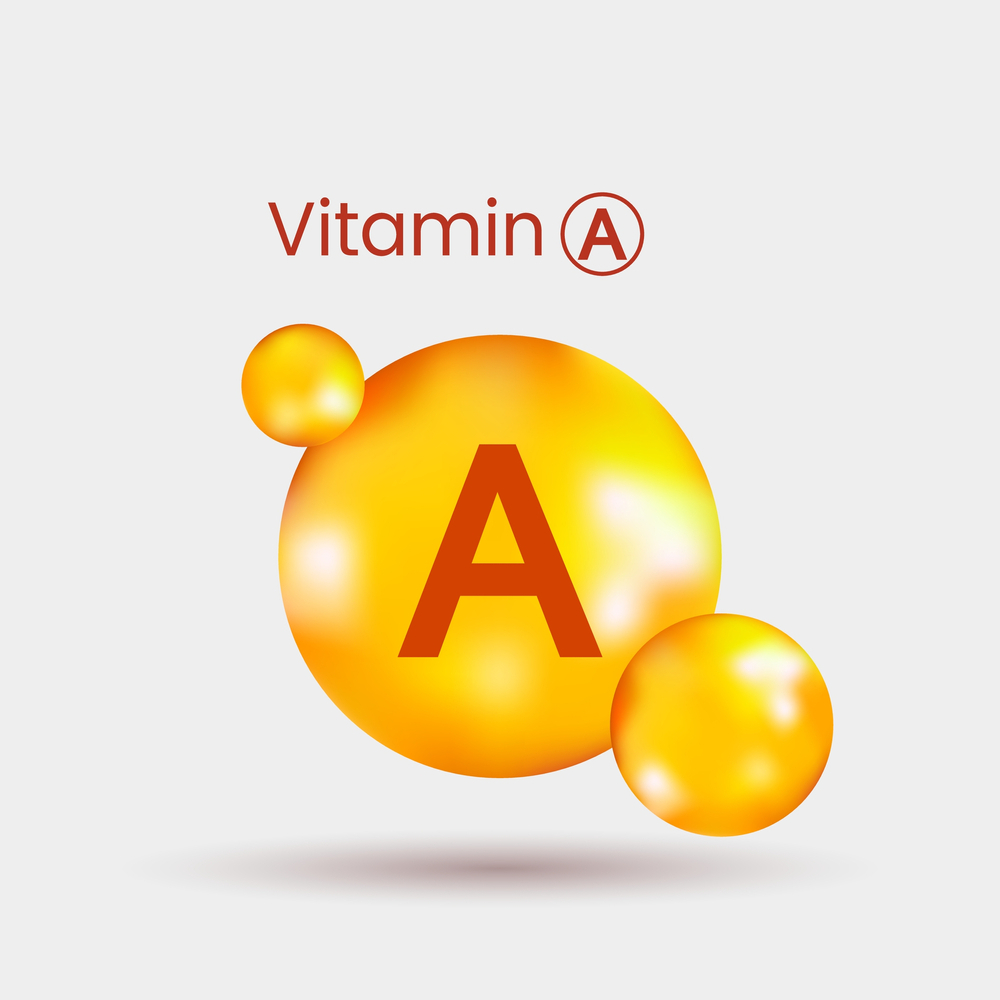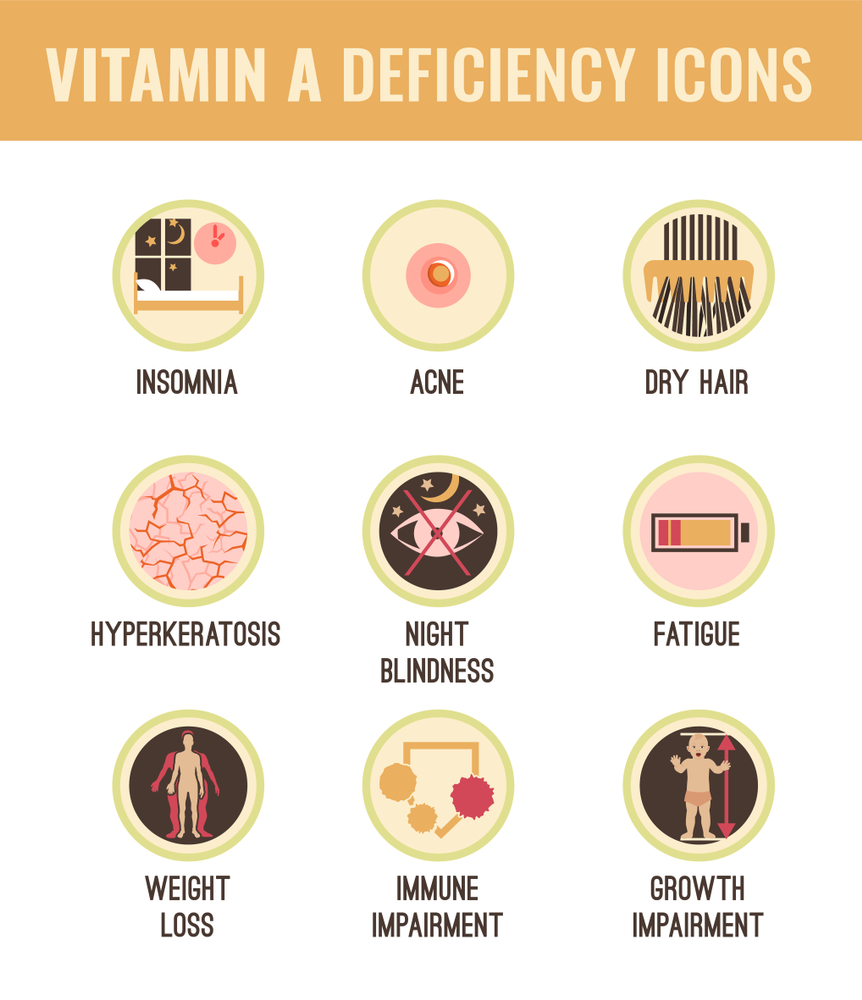- What exactly is vitamin A deficiency?
- What is the significance of vitamin A?
- Vitamin A forms
- Vitamin A Deficiency Symptoms
- Other signs and symptoms
- Who is at risk of vitamin A deficiency?
- How Is Vitamin A Deficiency Detected?
- What are the treatment and prevention options for vitamin A deficiency?
- What Foods Have Vitamin A?
- Too Much Vitamin A Can Be Dangerous?
Vitamins are a group of compounds that the body needs in small amounts to stay healthy. Vitamin A cannot be produced by the human body, so it must be obtained through diet. It is also important for maintaining healthy eyes, vision, skin, and infection resistance. Vitamin A is also referred to as retinol.

It is abundant in liver, milk, eggs, and fish liver oils. Beta carotene (found in green leafy vegetables and orange/yellow fruits and vegetables) can also be converted to vitamin A by your body.
On the other hand, mild forms of vitamin A deficiency are usually treatable without long-term consequences. However, vitamin A deficiency is far more prevalent in low-income countries, where it is often severe, resulting in vision loss and even death.
What is vitamin A deficiency, exactly?
A lack of vitamin A in your body is caused by a diet lacking in adequate amounts of vitamin A. Over time, a lack of vitamin A can also cause vision problems and a reduced ability to fight infections.
What is the function of vitamin A in the body?
Vitamin A is required for a number of bodily functions. Vitamin A is also required for the following functions, according to the National Institutes of Health (NIH):
vision,
immunity,
system of reproduction,
communication between cells
Vitamin A is also necessary for cell growth in other areas, including the heart, lungs, kidneys, and other organs, as well as the normal formation and function of cells.
Vitamin A comes in various forms.
There are two kinds of vitamin A in the human diet. The first is retinol, a preformed vitamin A derived from animal sources such as meat, fish, and dairy.
The second type of carotenoids is provitamin A carotenoids, such as beta carotene.
In their natural state, these compounds are not usable forms of vitamin A, but the body converts them into usable forms.
Both forms of the vitamin will be further metabolized in the body, resulting in active retinal and retinoic acid.
Symptoms of Vitamin A Deficiency

The severity of the symptoms of vitamin A deficiency varies. Some people may have more serious complications than others. The following are some of the symptoms:
1. Nighttime blindness
As a result, you have trouble seeing in dim light. It will eventually cause complete nighttime blindness.
2. Xerophthalmia
It is a condition in which the eyes become dry.
As a result of this condition, the eyes may become extremely dry and crusted, causing corneal and retinal damage.
3. Virus infection
A person who is deficient in vitamin A may have more frequent health problems because they are unable to fight infections as easily.
4. Bitot’s spots
A buildup of keratin in the eyes causes this condition, which also results in hazy vision.
5. Skin itch
It is a condition that occurs when the skin is scratched.
Skin problems such as dryness, itching, and scaling can occur in people who are deficient in vitamin A.
6. Keratomalacia
This is a condition that causes the cornea, the clear layer in front of the iris and pupil, to dry out and cloud.
7. Keratinization
This is the process by which cells in the urinary, gastrointestinal, and respiratory tracts fill with keratin protein, die, and form tough resistant structures.
8. The rate of growth has slowed.
Children who do not consume enough vitamin A may also experience slow bone growth, delayed growth, or stunted growth.
9. Fertility
A lack of vitamin A can make it difficult to conceive and, in some cases, result in infertility.
Other signs and symptoms
-Impaired immunity, resulting in gastrointestinal and respiratory tract infections in children
-Child growth retardation
The most common causes of vitamin A deficiency are as follows:
A long-term vitamin A deficiency in the diet
This deficiency is common in parts of the world where people don’t eat enough vitamin A-rich foods like carrots.
-Animal and fish livers
-Vegetables in orange, yellow, and dark green hues, as well as fruits in yellow and orange hues
-Eggs
-Milk fortified with vitamins and minerals
Vitamin A deficiency, for example, is common in southern and eastern Asia, where regular rice, which contains no vitamin A, is the primary food. Furthermore, golden rice contains more beta carotene, which may aid in vitamin A deficiency.
Disorders that impair fat absorption in the intestine can also impair fat-soluble vitamin A absorption and increase the risk of vitamin A deficiency.
These disorders include chronic diarrhea, celiac disease, cystic fibrosis, certain pancreatic disorders, and bile duct blockage. Furthermore, if you have surgery on your intestine or pancreas, the same thing can happen.
Moreover, liver problems can make it difficult to store vitamin A. (The liver is where the majority of the body’s vitamin A is stored.)
Vitamin A deficiency, on the other hand, is common in people who have long suffered from severe protein and calorie deficiency (protein-energy undernutrition). People with this disorder do not get enough vitamin A, and as a result, their vitamin A storage and utilization are impaired.
Who is prone to vitamin A deficiency?
Vitamin A deficiency is common in Africa and Southeast Asia, where 250 million preschoolers are estimated to be deficient due to a lack of carotenoids in their diet. Severe infection, especially measles, aggravates symptoms.
Adults with gastrointestinal diseases that impair vitamin A absorption may also be vitamin A deficient. Here are a couple of examples:
-Coeliac disease
-Cirrhosis of the liver
-Insufficiency of the pancreas
-Bile duct dysfunction
-Giardiasis
-Duodenal bypass surgery
How Can Vitamin A Deficiency Be Identified?
A doctor will begin with an eye exam and a review of your medical history. A blood test to determine the level of vitamin A in your blood may also be performed.
Because vitamin A deficiency is more common in impoverished communities with limited medical access, the diagnosis is frequently made on the spot. For example, if a mother mentions that her child has night blindness, the doctor may assume that it is caused by a lack of vitamin A.
What are the options for treating and preventing vitamin A deficiency?

Vitamin A deficiency is treated orally with 60,000 IU of vitamin A palmitate oil for two days, followed by 4,500 IU per day.
Furthermore, the alternate dosing method is as follows:
Moreover, infants under 6 months old receive 50,000 IU, infants 6–12 months receive 100,000 IU, and adults receive 200,000 IU.
A diet rich in the following foods can aid in the prevention of vitamin A deficiency:
-Spinach-kale
-collards -broccoli -and-other-green-leaved-vegetables
Fruits high in beta-carotene, such as apricots or peaches, and colorful vegetables, such as carrots, squash, and sweet potatoes
Vitamin A-fortified milk or cereals
Egg yolks derived from the liver
Fish liver oils are a type of oil derived from the liver of a fish.
In developing countries, successful preventive measures include:
Breastfeeding advocacy
Children, on the other hand, should be given high-dose vitamins on a regular basis, and families should be encouraged to grow fruits and vegetables as a source of food supplementation.
What Foods Contain Vitamin A?

-Liver
This food has a high concentration of vitamin A. One serving of liver contains more vitamin A than a week’s worth of recommended daily intake.
-Fish
Oily fish, shellfish, and cod liver oil are all high in vitamin A and can also be consumed as whole foods or as supplements.
-Vegetables
Orange-colored vegetables have the highest levels of vitamin A. However, sweet potato is the most common.
-pumpkin
-carrot
-squash
Other green leafy vegetables to consider include spinach, greens, and lettuce. Furthermore, experts recommend cooking or processing these vegetables to get the full benefit of vitamin A and make it easier for the body to digest and absorb its nutritional value.
-Milk-derived products
In general, milk is a good source of vitamin A, though the amount in skim milk is lower than in full cream milk. Furthermore, many soft cheese slices may contain vitamin A, with cheddar cheese having the highest concentration.
-Fruits
The most common fruits high in vitamin A are -oranges.
ripe mangoes
-papaya
-melon cantaloupe
-apricots
-which can be eaten fresh or dried
Because vitamin A is best absorbed in fat particles in the gut or intestine, including some healthy fats in your diet is beneficial.
Is Too Much Vitamin A Dangerous?

Vitamin A is necessary for good health. Too much of it, however, can be hazardous.
Taking high-dose supplements for an extended period of time is a common cause of hypervitaminosis A, also known as vitamin A toxicity. However, people rarely get too much vitamin A from their diet.
Excess vitamin A is stored in the liver and can cause toxicity as well as unpleasant symptoms such as vision changes, bone swelling, dry and rough skin, mouth ulcers, and confusion.
To avoid birth defects, pregnant women should be especially cautious about consuming too much vitamin A.
Always consult with your healthcare provider before beginning vitamin A supplements.
Certain medical conditions may necessitate a higher intake of vitamin A. Most healthy adults, on the other hand, require 700–900 mcg per day. Nursing mothers require more, while children require less.
Also Read Vitamin D Deficiency- Everything You Must Know About It – V Cure (vcurehealthcare.com)





